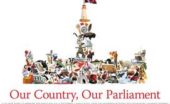Johannah Bernstein post: "eternally proud of my father’s extraordinary aeronautical engineering. legacy. here is a photo of the Canadair Water…
Canada’s 44th Parliament
Written by Diana Thebaud Nicholson // December 6, 2021 // Canada, Government & Governance // Comments Off on Canada’s 44th Parliament
The most important committees you’ve never heard of
(Politico Ottawa Playbook) At long last, the federal Cabinet has committees and ministers have parliamentary secretaries. Friday’s announcements reveal a post-election hierarchy: Who the PMO trusts most, which cabmins are workhorses, and which Liberal caucus colleagues are on the outside looking in.
They may sound drab and unexciting, but Cabinet committees play a crucial role in actually getting things done. Every government program lands at a committee for debate and approval — even Covid recovery initiatives developed on the fly.
… Priorities and planning: The PM chairs this one, which includes trusted ministers who steer the overall agenda. This top tier includes AHMED HUSSEN, MÉLANIE JOLY, MARY NG, PABLO RODRIGUEZ, LeBlanc, Qualtrough and Blair. …
This was the other end-of-week announcement. The significance of parliamentary secretaries varies depending on the portfolio and the minister, but they can serve as key players — especially with stakeholders — and durable parliamentary stand-ins. The capital was growing impatient with the lack of understudies as the House wrapped up its second week.
Finally, some backup: Here’s the list of parlsecs. Eagle-eyed Playbook readers noted strategic geographic offsets.
November/December issue Policy
The 44th Parliament including contributions from Thomas Axworthy (Meet the New Minority Government, Just Like the Old Minority Government), Jeremy Kinsman (How Building a Multilateral System Fairer for All Could Revive American Leadership) and Bob Rae (Letter from the United Nations: Isolationism vs. Collective Action)
Libs only want Finance, Procedure committees running by Christmas
While opposition parties want all House committees running as soon as possible, the Liberals are proposing that just the Finance and Procedure committees be set up before Parliament rises for its winter break, two sources familiar with the situation told iPolitics.
The Conservatives contend they want to get to work now, while the Liberals want to evade parliamentary scrutiny until at least February, one source said.
On Dec. 17, the House will rise for six weeks for its usual holiday break. MPs won’t sit again until the last day of January.
23 November
Liberals prioritize COVID, climate, reconciliation
(iPolitics) Today was Throne Speech Day, so we begin in the Senate, where Gov. Gen. Mary May Simon delivered her first. In laying out the government’s vision for the 44th Parliament, it was essentially a summary of Liberal promises from September’s federal election, and reiterated long-standing Liberal promises to take action on climate, reconciliation, and COVID-19. “The decade got off to an incredibly difficult start, but this is the time to rebuild,” Simon said.
The government’s first priority remains getting the pandemic under control, which is best done through vaccination, she said. Further plans on health care include improving accessibility, mental health and addiction treatment, long-term care, and data collection. She noted that the government plans to tackle the rising cost of living by prioritizing affordable housing and child care.
Growing the economy goes hand in hand with protecting the environment and “by focusing on innovation and good, green jobs, and by working with like-minded countries – we will build a more resilient, sustainable, and competitive economy,” Simon said. She repeated the government’s promises to cap oil and gas sector emissions, increase the price on pollution, and accelerate a net-zero electricity future, while also noting the government wants Canada to be a leader in producing the world’s clean steel, aluminum, building products, cars, and planes.
As the first Indigenous Governor General, Simon delivered the speech in her native tongue, Inuktitut, as well as in English and in French.
Speech from the Throne
21-22 November
New Parliament, old traditions: Here’s what to expect when MPs return this week
(CBC) The opening days of the 44th Canadian Parliament this week will be steeped in age-old British traditions that may seem a little strange to some.
Things kick off with the election of a Speaker of the House of Commons on Monday. That will be followed Tuesday by Gov. Gen. Mary May Simon’s reading of the throne speech, which spells out the government’s legislative priorities and officially opens a new session of Parliament.
While members of Parliament can’t get down to any parliamentary business until that throne speech has been read, the journey to get there isn’t straightforward.
Once the pomp and ceremony are behind them, MPs will have about four weeks before the scheduled holiday break on Dec. 17 to get stuff done.
The Liberal government will move forward with legislation to implement new emergency aid benefits that it says will be more “targeted” toward individuals and hard-hit businesses in this phase of the pandemic.
The Liberals also promised in the last election to introduce or bring back eight bills within their first 100 days.
Liberal Anthony Rota re-elected by MPs as House of Commons Speaker
His re-election Monday to a second term as Speaker was no surprise as he had been widely praised, even by opposition parties, for deftly steering the House through the COVID-19 pandemic in a fair and non-partisan manner.
The last parliamentary session was unprecedented, including huge technical and procedural challenges to enable introduction of a hybrid format that gave MPs for the first time the option to participate virtually in proceedings to avoid spreading the virus.
Rota had also been widely praised for his good humour and calm demeanour refereeing proceedings during what were often heated exchanges among MPs from rival parties in a Commons where the Liberal government held only a minority of seats.
MPs gather to choose House referee
By Kady O’Malley
(iPolitics)According to the latest dispatch from House administration, there are seven candidates up for consideration, including incumbent Anthony Rota.
According to the Canadian Press, [Elizabeth] May has already said that she “believes Rota deserves to be re-elected,” but is hoping to use the five-minute speaking time allotted to each candidate to “draw attention to what she considers a major error by various Speakers over the past 40 years: allowing party whips to dictate who gets to speak in the Commons, surrendering the Speaker’s authority to choose whom to recognize.”
As it stands, Rota remains the odds-on favourite to win, but as CP points out, “ranked ballots … can be unpredictable.”
Coping with disaster: What’s at stake for the Prime Minister as parliament returns
Catastrophic flooding in British Columbia, aggressive trade negotiations in Washington D.C. and a long list of promises made during the election are all on the minds of MPs as they return to Ottawa for the 44th session of Parliament. Piya Chattopadhyay checks in with Vancouver Sun columnist Vaughn Palmer, Winnipeg Free Press columnist Niigaan Sinclair and the Toronto Star’s national columnist Susan Delacourt for their takes on the political parties’ priorities as they get back on Parliament Hill on Monday.
Reading the Room: Challenges for the Next Trudeau Mandate
Just when it seemed that Canada’s post-pandemic politics might be calmer than the health, economic and political rollercoaster of the past two years, turns out the new Parliament will be almost precisely as querulous as the last one, and between COVID, climate change, China and cyber, suddenly all politics is global. Longtime Liberal strategist and Hill + Knowlton VP John Delacourt surveys the horizon.
(Policy November/December) The first session of Canada’s 44th Parliament is set to open on November 22nd, just one day short of five months since MPs in the 43rd Parliament last took their seats in the House of Commons on June 23rd. If you were a member of the last Liberal caucus, this period will no doubt be remembered as the most grinding route from minority government to virtually identical minority government, like two Trans-Siberian Railway stops along our strange, second COVID summer, across the economic permafrost of the fourth wave.
But reading the national room is clearly harder than it would appear. If all had gone as planned for Trudeau’s Liberals, November’s speech would have been expected to herald a majority mandate as transformative as the New Deal, not a be-humbled recitation of platform commitments from a Pyrrhic victory.
If the realpolitik imperative behind any minority government is to position the team for a majority triumph the next time around, that challenge has never looked quite as daunting for the Prime Minister and his closest advisors. How does a government put a bright shine on transformation, when most Canadians are intuiting that a deeper transformation is occurring, fomenting a sense of loss and uncertainty that perhaps no government is capable of addressing on its own?
8 November
Trudeau rallies troops as MP confirms early talks with Singh on minority government
NDP MP Charlie Angus says Trudeau and Singh have had initial discussion about working together
28 October
Revealed! The secret to getting appointed to the Trudeau cabinet
as the population ages, it’s important to have a House of Commons and a cabinet that reflects the population. If we need people to stay in the workforce longer, why shouldn’t it be the same for politicians in their 60s and 70s? What kind of example does it send to turf competent ministers, just because they’ve been around awhile?
(iPolitics) You might think that Justin Trudeau is Canada’s youth prime minister. Not really. At 49, he’s Canada’s middle-aged prime minister. More precisely, he’s Canada’s leader of generation X.
It’s striking. Of the 38 members in Trudeau’s new cabinet, 20 are in their 50s. Two-thirds are between the ages of 45 and 59. It’s obviously the key to being appointed a minister.
Does it all matter? If gender equity is important in building a cabinet, and if balanced regional representation is essential, why shouldn’t age be a consideration? Why should the 45-to-59 cohort, which represents less than 20 per cent of Canada’s population, hoover up 66 per cent of the portfolios in the federal cabinet?
When Trudeau swept into office in 2015, he brought along his buddies, from Gerry Butts to Katie Telford and Mary Ng (who, at 51, is now minister of International Trade), and ensconced them at the PMO. From the start, there were allegations of ageism. The Trudeau crew wanted nothing to do with the old Liberals, any of them, from Jean Chrétien to John Manley. (28 October)

